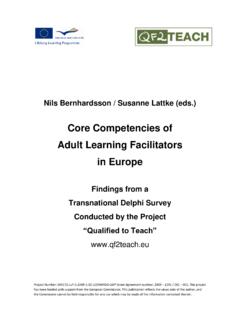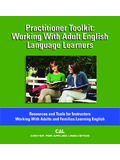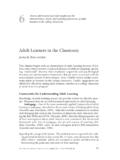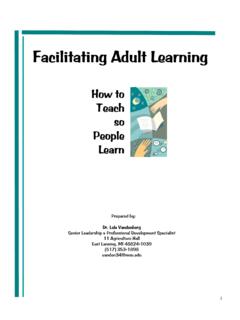Transcription of Co-Teaching Resource Guide - LASPDG
1 1 2 Co-Teaching Resource Guide OVERVIEW COLLABORATIVE teaching The Individuals with Disabilities education Act (IDEA) requires that all students with disabilities have access to the general education curriculum and that their instructional programs be delivered in the Least Restrictive Environment (LRE). In addition, the No Child Left Behind (NCLB) Act requires that students with disabilities have access to the general education curriculum and be included in state-wide and district-wide assessments and accountability systems.
2 Inclusive Practices Inclusive practices are academic and behavioral supports and strategies provided to students with disabilities in general education settings. The overall goal of implementing inclusive practices is to improve outcomes for students with disabilities through the implementation of appropriate academic and behavioral supports. Inclusive schools are those that educate students with disabilities in age-appropriate general education classes with the provision of specialized instruction and appropriate supports and accommodations as required by their Individualized education Plans (IEPs).
3 Specialized instruction and supports are provided in the context of general education classes and activities. Students with disabilities are valued as full members of the student body and provided opportunities to participate in all aspects of school life. Collaborative Models For inclusive practices to be effective, both general education and special education staff must work together to create powerful learning environments for all students. There are three basic models that outline how supports and accommodations may be provided to students with disabilities in general education settings.
4 All require general and special educators to collaborate to ensure that positive student outcomes are evidenced. Co-Teaching Support Model The Co-Teaching support model consists of a special education teacher partnering with a general education teacher to meet the instructional goals of students with and without disabilities in a general education setting. Two teachers work together to meet the needs of not only students with disabilities assigned to the general education class but also students without disabilities assigned to the class.
5 Both teachers share responsibility for planning, delivering instruction, assessing, and managing classroom discipline and student behavior. Both teachers share responsibility for providing supports and accommodations to meet the needs of all students in the class. Co-Teaching Consultant Paraeducator 3 Consultant Support Model The consultant support model consists of a special education teacher providing direction and feedback to a general education teacher (s) regarding students with disabilities in general education settings.
6 The special education teacher provides on-going support to the general education teacher (s) to ensure instructional support needs of students with disabilities are addressed in the general education class. The special education teacher adapts lessons and identifies accommodations and instructional strategies appropriate to specific students. The special education teacher articulates the needs of students with disabilities and serves as the liaison between the general education teacher (s) and other special education teachers regarding student progress (if the students also receive special education instruction in a special education class).
7 Paraeducator Support Model The paraeducator support model consists of a paraeducator supporting students with disabilities in general education settings under the direction of a general education teacher . Rarely, unless the para is a child specific para, will the para be assigned to a co-taught class. If there is a second adult already in the classroom, a para is probably not needed. Even though the para is working directly under the guidance of a general education teacher , s/he and the special education teacher of record must maintain on-going communication in order to ensure the supports outlined on students IEPs are implemented in the general education class.
8 The paraeducator facilitates the successful inclusion of students with disabilities in general education settings by assisting the general education teachers in implementing appropriate supports and accommodations. LRE Continuum The IDEA requires the IEP team to consider a continuum of least restrictive environments when identifying the setting in which the instructional program for students with disabilities will be provided. The instructional program setting for specific students may range from inclusion in general education classes all day to instruction provided all day in special education classrooms.
9 However, emphasis must be on providing the appropriate program in the least restrictive environment. Therefore, IEP teams must consider placement in general education settings as the first placement. Research A growing body of research indicates the most positive student outcomes are evidenced by the inclusion of students with disabilities in general education settings. Data demonstrate that students in inclusive classrooms show academic and behavioral gains far greater than students in segregated special education classrooms.
10 While the decision of IEPs teams for some students may continue to include instruction in special education settings, for many students inclusion in general education settings, with supports and accommodations, is the optimal setting for better outcomes. In addition, research indicates the most effective way to support students with 4 disabilities in general education settings is by using a Co-Teaching support model. This is not to say that the consultant or paraeducator support models are not effective, just that the Co-Teaching model yields better and more positive outcomes.











